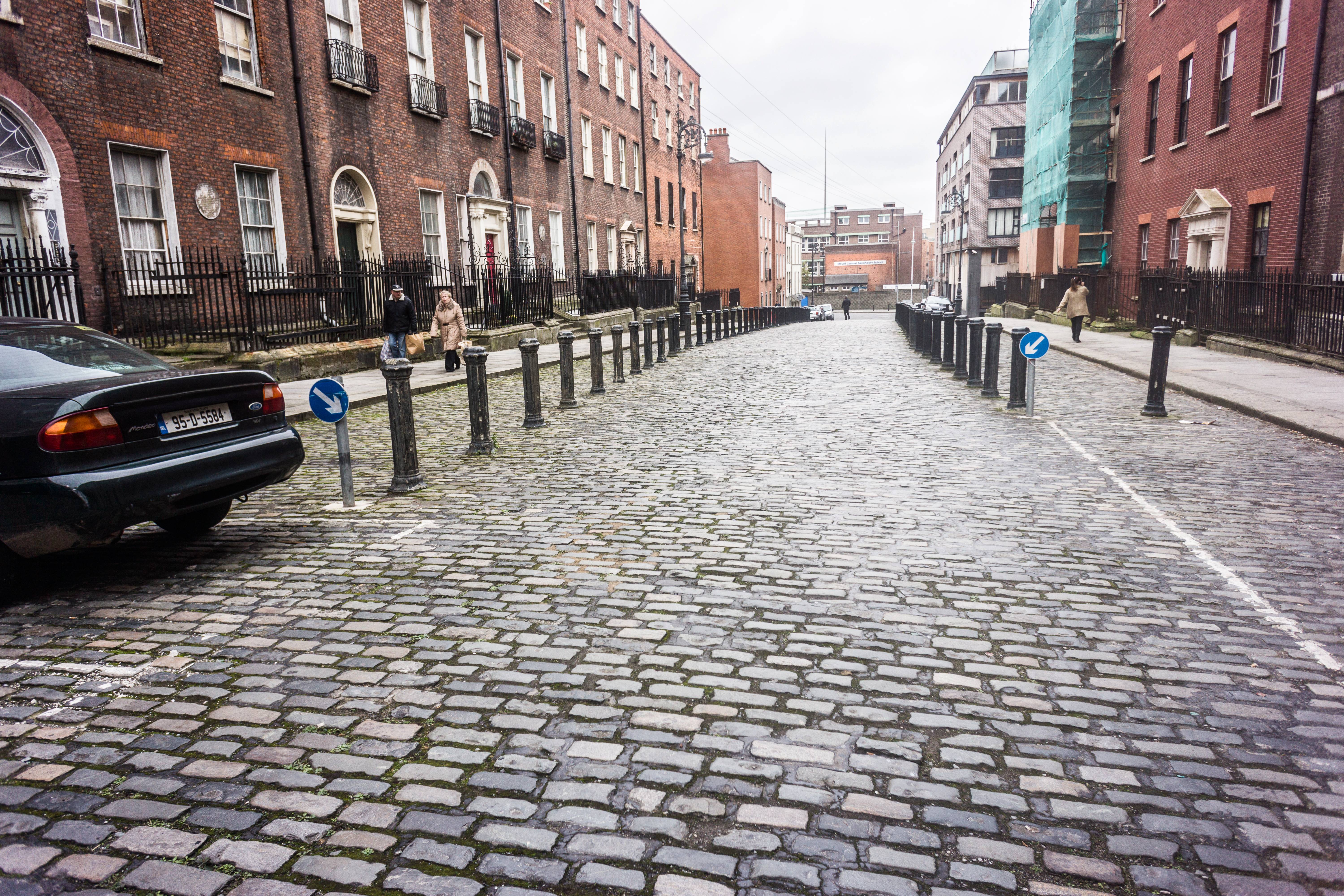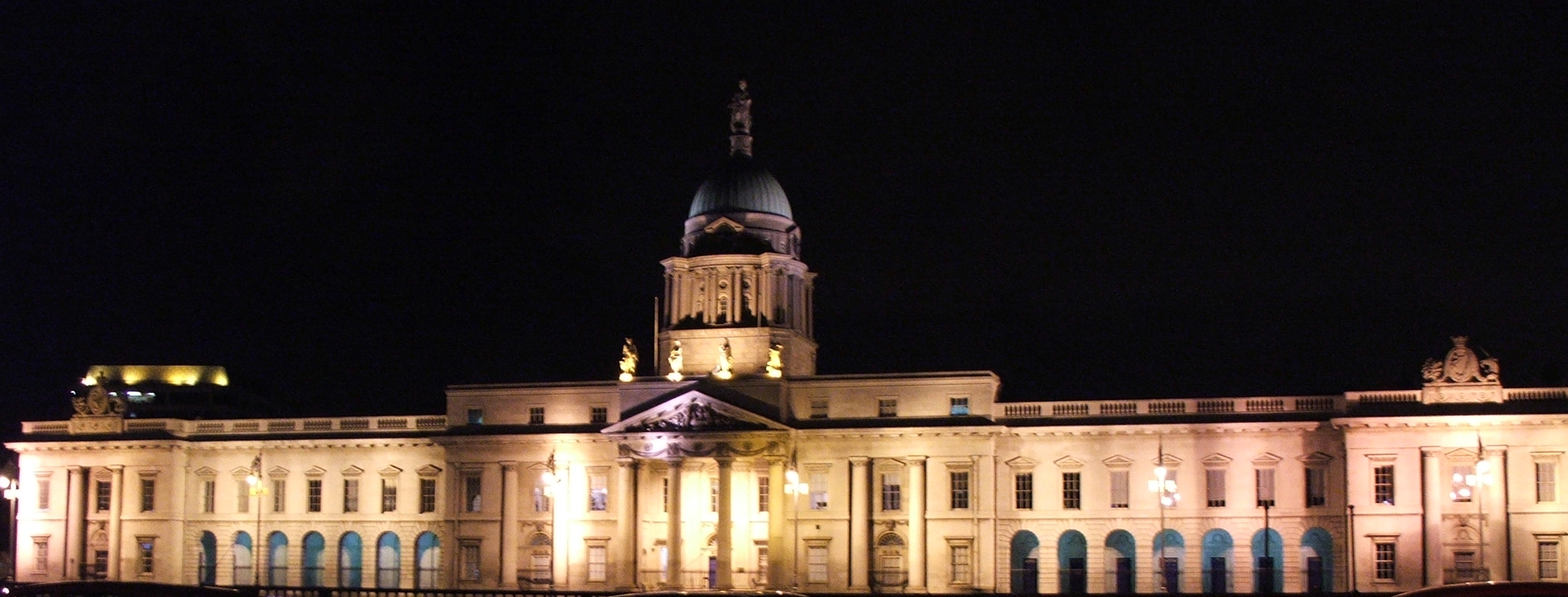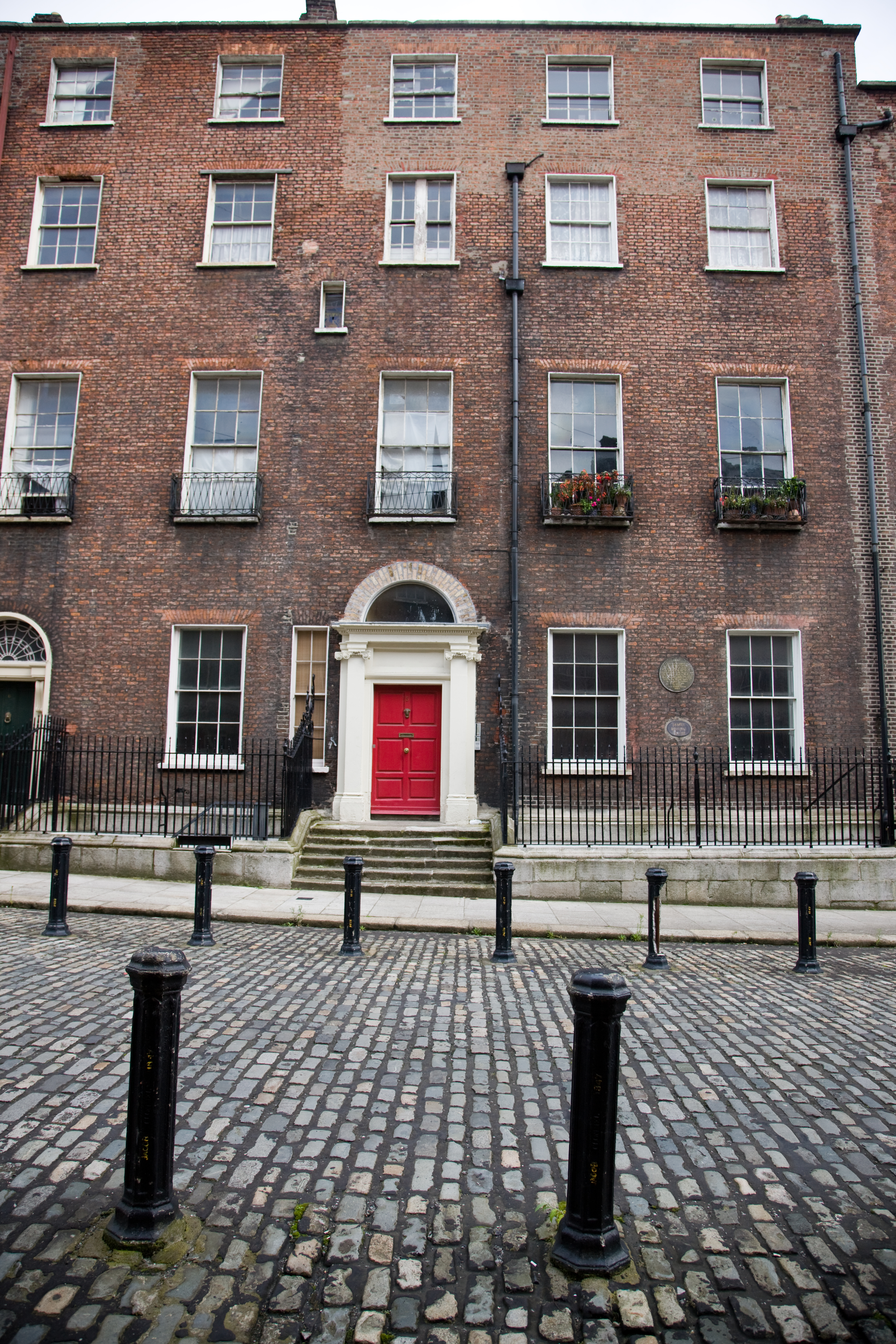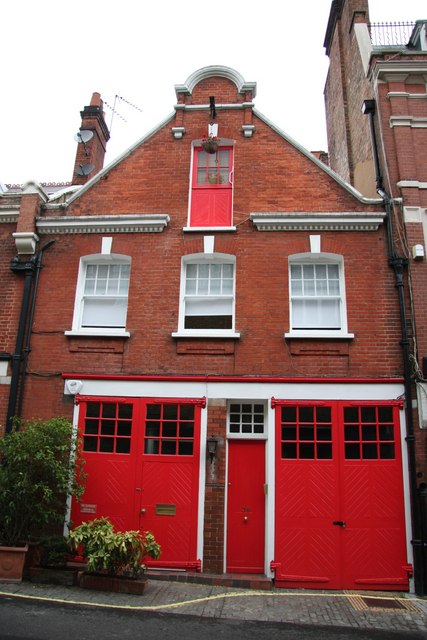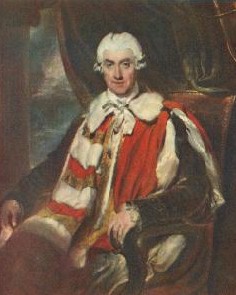|
Henrietta Street, Dublin
Henrietta Street () is a Dublin street, to the north of Bolton Street on the north side of the city, first laid out and developed by Luke Gardiner during the 1720s. A very wide street relative to streets in other 18th-century cities, it includes a number of very large red-brick city palaces of Georgian design. Name The street is generally held to be named after Henrietta (née Somerset; 1690–1726), the wife of Charles FitzRoy, 2nd Duke of Grafton, although an alternative candidate is Henrietta (née Crofts; 1697–1730), third wife of Charles Paulet, 2nd Duke of Bolton. The nearby Bolton Street is named after Paulet. History Henrietta Street is the earliest Georgian Street in Dublin, and at the forefront of Dublin's later Georgian streetscapes. Construction on the street started in the mid-1720s, on land bought by the Gardiner family in 1721. Construction was still taking place in the 1750s. Gardiner had a mansion, designed by Richard Cassels, built for his own use around ... [...More Info...] [...Related Items...] OR: [Wikipedia] [Google] [Baidu] |
James Gandon
James Gandon (20 February 1743 – 24 December 1823) was an English architect best known for his work in Ireland during the late 18th century and early 19th century. His better known works include The Custom House and the surrounding Beresford Place, the Four Courts and the King's Inns in Dublin and Emo Court in County Laois. Early life Gandon was born on 20 February 1742 in New Bond Street, London, at the house of his grandfather Peter Gandon, a French Huguenot refugee. He was the only son of Peter Gandon (b. 1713), a gunmaker, and Jane Burchall (possibly née Wynne). From 1749 he was educated at Shipley's Drawing Academy where he studied the classics, mathematics, arts and architecture. On leaving the drawing academy he was articled to study architecture in the office of Sir William Chambers. Chambers was an advocate of the neoclassical evolution of Palladian architecture, although he later made designs in the Gothic Revival style. However, it was Chambers's palladia ... [...More Info...] [...Related Items...] OR: [Wikipedia] [Google] [Baidu] |
Richard Cassels
Richard Cassels (1690 – 1751), also known as Richard Castle, was an architect who ranks with Edward Lovett Pearce as one of the greatest architects working in Ireland in the 18th century. Cassels was born in 1690 in Kassel, Germany. Although German, his family were of French origin and descended from the French-Netherlandish 'Du Ry' family, famous for the many architects among their number. A cousin Simon Louis du Ry designed Schloss Wilhelmshöhe in Kassel. Early work Richard Cassels, who originally trained as an engineer, came to Ireland in 1728 at the behest of Sir Gustavus Hume of County Fermanagh to design for Hume a mansion on the shores of Lower Lough Erne. Hume had probably discovered Cassels working in London where he was influenced by the circle of architects influenced by Lord Burlington. Cassels, soon after arrival in Ireland, established a thriving architectural practice in Dublin. Architecturally at the time Dublin was an exciting place to be – ... [...More Info...] [...Related Items...] OR: [Wikipedia] [Google] [Baidu] |
Nathaniel Clements
Nathaniel Clements (1705 – May 1777) was an Irish politician and financial figure, important in the political and financial administration of Ireland in the mid-18th century. Early history Clements was the fifth son of Robert Clements (1664–1722). He married Hannah Gore, daughter of William Gore, D.D., Dean of Down, on 31 January 1730. Career Clements became Member of Parliament (MP) for Duleek in 1727 under the patronage of Luke Gardiner, a powerful political and business figure in Dublin. He commenced as a junior at the Irish Treasury in 1720 and held extensive offices there. He became the main financial manager of the British and Irish Government in Ireland during the period, and was ''de facto'' Minister for Finance from 1740 to 1777. He assumed the offices of Deputy Vice-Treasurer and Deputy Paymaster General on Gardiner's retirement in 1755. In 1761, Clements was returned for Cavan Borough in, holding this seat until 1768. In this year, he was elected for Roscom ... [...More Info...] [...Related Items...] OR: [Wikipedia] [Google] [Baidu] |
George Stone (bishop)
George Stone (1708 – 19 December 1764) was the Church of Ireland Archbishop of Armagh (Primate of All Ireland) from 1747 to his death. Advancement Born in London, the son of Andrew Stone, a London goldsmith. He was educated at Westminster School and Christ Church, Oxford. Having taken holy orders, his advancement in the Church was very rapid, mainly through the influence of his older brother Andrew Stone. Andrew's connections with George II made him able to promote the preferment of his brother George, who went to Ireland as chaplain to Lionel Sackville, 1st Duke of Dorset when that nobleman became Lord Lieutenant of Ireland in 1731. In 1733 Stone was made Dean of Ferns, and in the following year he exchanged this deanery for that of Derry. In 1740 he became Bishop of Ferns and Leighlin, in 1743 Bishop of Kildare, in 1745 Bishop of Derry, and in 1747 Archbishop of Armagh. During the two years that he occupied the See of Kildare he was also Dean of Christ Church, Dublin. ... [...More Info...] [...Related Items...] OR: [Wikipedia] [Google] [Baidu] |
Earl Of Thomond
Earl of Thomond was an hereditary title in the Peerage of Ireland. It was created twice for the O'Brien dynasty which is an ancient Irish sept native to north Munster. History and background First creation Under the Crown of Ireland Act 1542, King Henry VIII of England was created King of Ireland by the Parliament of Ireland. In consequence, all reigning monarchs and clan chiefs in Ireland were ordered to surrender their native titles in return for peerages. This surrender and regrant offer was conditional upon the adoption of Tudor customs and laws, including pledging allegiance to the Irish Crown and apostatising from the Catholic faith by accepting the articles of the state established Church of Ireland. Through surrender and regrant, the earldom of Thomond was created in 1543 for Murrough O'Brien. He had previously been styled King of Thomond and was descended from the ' or High King of Ireland, Brian Boru. O'Brien was also created Baron Inchiquin, on 1 July 1543. ... [...More Info...] [...Related Items...] OR: [Wikipedia] [Google] [Baidu] |
John Maxwell, 1st Baron Farnham
John Maxwell, 1st Baron Farnham (1687 – 6 August 1759) was an Irish peer and politician. He was the son of the Reverend Robert Maxwell and Anne Stewart, daughter of Colonel George Stewart. His paternal grandfather was Robert Maxwell, Bishop of Kilmore. He was appointed Prothonotary of the Court of Common Pleas (Ireland) and held the office from 1725 until his death. He was a member of parliament (MP) of the Irish House of Commons for County Cavan from 1727 to 1756. He inherited Farnham estate from his cousin in 1737 and was appointed High Sheriff of Cavan for 1739. The latter year he was raised to the Peerage of Ireland as Baron Farnham, of Farnham in the County of Cavan. He had married in 1719 Judith Barry, daughter of James Barry of Newton Barry and Anne Meredyth, and had the following children: # Robert Maxwell, 1st Earl of Farnham, 2nd Baron Farnham (born – died 16 November 1779 without male issue). (Earldom extinct, 1779) # Barry Maxwell, 1st Earl of Farnham ... [...More Info...] [...Related Items...] OR: [Wikipedia] [Google] [Baidu] |
Owen Wynne (1687–1756)
Owen Wynne (1687 – 1 June 1756) was an Irish Member of Parliament. He sat in the House of Commons of Ireland The Irish House of Commons was the lower house of the Parliament of Ireland that existed from 1297 until 1800. The upper house was the House of Lords. The membership of the House of Commons was directly elected, but on a highly restrictive fr ... from 1713 to 1756. He was an MP for Sligo Borough from 1713 until 1756. References 1687 births 1756 deaths Members of the Parliament of Ireland (pre-1801) for County Sligo constituencies Irish MPs 1713–1714 Irish MPs 1715–1727 Irish MPs 1727–1760 {{Ireland-pre1801-MP-stub ... [...More Info...] [...Related Items...] OR: [Wikipedia] [Google] [Baidu] |
Henrietta Street - Dublin 2800071378
Henrietta may refer to: * Henrietta (given name), a feminine given name, derived from the male name Henry Places * Henrietta Island in the Arctic Ocean * Henrietta, Mauritius * Henrietta, Tasmania, a locality in Australia United States * Henrietta, Missouri * Henrietta, Johnson County, Missouri * Henrietta, New York * Henrietta, Ohio * Henrietta, Pennsylvania * Henrietta, Texas * Henrietta, West Virginia * Henrietta, Wisconsin, a county subdivision ** Henrietta (ghost town), Wisconsin, a ghost town * Henrietta Township: ** Henrietta Township, Michigan ** Henrietta Township, Hubbard County, Minnesota ** Henrietta Township, Lorain County, Ohio ** Henrietta Township, LaMoure County, North Dakota Fictional characters * Henrietta de Tristain a fictional character from the Japanese light novel/anime '' Zero no Tsukaima'' * Henrietta the coach, a fictional character of ''The Railway Series'' * Henrietta (Gunslinger), a fictional character from the Japanese manga/anime ''Gu ... [...More Info...] [...Related Items...] OR: [Wikipedia] [Google] [Baidu] |
Mews
A mews is a row or courtyard of stables and carriage houses with living quarters above them, built behind large city houses before motor vehicles replaced horses in the early twentieth century. Mews are usually located in desirable residential areas, having been built to cater for the horses, coachmen and stable-servants of prosperous residents. The word mews comes from the Royal Mews in London, England, a set of royal stables built 500 years ago on a former royal hawk mews. The term is now commonly used in English-speaking countries for city housing of a similar design. After the advent of World War Two, mews were replaced by alleys and the carriage houses by garages for automobiles. Hawk mews Mews derives from the French ''muer'', "to moult", reflecting its original function to confine hawks while they moulted.''Oxford English Dictionary'' online, accessed 17 February 2019 Shakespeare deploys ''to mew up'' to mean confine, coop up, or shut up in ''The Taming of the Shr ... [...More Info...] [...Related Items...] OR: [Wikipedia] [Google] [Baidu] |
Peerages In The United Kingdom
The peerages in the United Kingdom are a legal system comprising both hereditary and lifetime titles, composed of various noble ranks, and forming a constituent part of the British honours system. The term ''peerage'' can be used both collectively to refer to the entire body of nobles (or a subdivision thereof), and individually to refer to a specific title (modern English language-style using an initial capital in the latter case but not the former). British peerage title holders are termed peers of the Realm. The peerage's fundamental roles are ones of government, peers being eligible (although formerly ''entitled'') to a seat in the House of Lords, and of meritocracy, the receiving of any peerage being the highest of British honours (with the receiving of a more traditional hereditary peerage naturally holding more weight than that of a more modern, and less highly regarded, ''life'' peerage). In the UK, five peerages or peerage divisions co-exist, namely: * The Peerage of ... [...More Info...] [...Related Items...] OR: [Wikipedia] [Google] [Baidu] |
Cul-de-sac
A dead end, also known as a cul-de-sac (, from French for 'bag-bottom'), no through road or no exit road, is a street with only one inlet or outlet. The term "dead end" is understood in all varieties of English, but the official terminology and traffic signs include many different alternatives. Some of these are used only regionally. In the United States and other countries, ''cul-de-sac'' is often not an exact synonym for ''dead end'' and refers to dead ends with a circular end, allowing for easy turning at the end of the road. In Australia and Canada, they are usually referred to as a ''court'' when they have a bulbous end. Dead ends are added to road layouts in urban planning to limit through-traffic in residential areas. While some dead ends provide no possible passage except in and out of their road entry, others allow cyclists, pedestrians or other non-automotive traffic to pass through connecting easements or paths, an example of filtered permeability. The Internatio ... [...More Info...] [...Related Items...] OR: [Wikipedia] [Google] [Baidu] |
Foyle's War
''Foyle's War'' is a British detective drama television series set during and shortly after the Second World War, created by ''Midsomer Murders'' screenwriter and author Anthony Horowitz and commissioned by ITV after the long-running series '' Inspector Morse'' ended in 2000. It began broadcasting on ITV in October 2002. ITV director of programmes Simon Shaps cancelled ''Foyle's War'' in 2007, but Peter Fincham (Shaps' replacement) revived the programme after good ratings for 2008's fifth series. The final episode was broadcast on 18 January 2015, after eight series. Description Detective Chief Superintendent Christopher Foyle ( Michael Kitchen), a widower, is quiet, methodical, sagacious, scrupulously honest and frequently underestimated by his foes. Many of his cases concern profiteering, the black market and murder, and he is often called on to catch criminals who are taking advantage of the confusion created by the war. Although Foyle often comes up against high-ranking ... [...More Info...] [...Related Items...] OR: [Wikipedia] [Google] [Baidu] |
